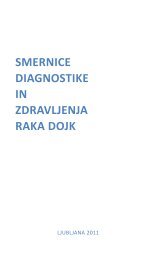You also want an ePaper? Increase the reach of your titles
YUMPU automatically turns print PDFs into web optimized ePapers that Google loves.
Microscope is made of a number of optical elements which enable us to se an enlarged<br />
picture of the specimen with a magnification of up to about 2000. Later we will<br />
calculate the theoretical limit of the magnification for a visible light microscope.<br />
Microscope structure<br />
Microscope is made of:<br />
a) The frame<br />
b) The light source<br />
c) illuminator<br />
d) condensor<br />
e) stage<br />
f) objectives<br />
g) revolving nosepiece<br />
h) tube<br />
i) oculars<br />
The structure of a microscope is shown on picture 2.<br />
Picture 2: Microscope structure<br />
Microscopy techniques<br />
The basic microscopy technique is the so called bright field – BF. All other techniques<br />
are based on this technique. The known techniques are shown in table 1.<br />
Bright field<br />
Dark field<br />
Phase contrast<br />
by Zernicke<br />
Olympus Relief Contrast<br />
Differential Interference Contrast<br />
By Nomarsky<br />
Polarisation<br />
Fluorescence<br />
BF<br />
DF<br />
PH<br />
ORC (HMC)<br />
DIC<br />
POL<br />
Fluor<br />
Table 1: microscopy techniques<br />
A description of each technique will be presented in the presentation.<br />
Complications<br />
With microscopy many complications are possible. These make work difficult or<br />
impossible. To be able to avoid such complications we will describe some of them,<br />
and also present the solutions.<br />
The description of complications and possible solutions will be described in the<br />
presentation.<br />
50

















